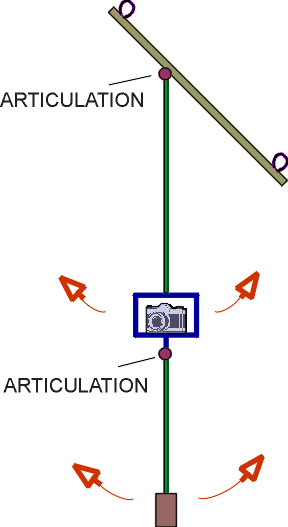
- lower mass:
- radio-control receiver,
- batteries.
-
|
|
- The thwarting pendulum is a compound pendulum: a first
pendulum is holding a second one. Depending on masses and
length of each one, the oscillations, when interfering,
by turns, adds or substracts.
- Therefore, instead to have a permanent oscillation that
the wind shifts are feeding and endure, time to time, the
movements are thwarted, and a short moment, the pendulum
is motionless.
- It is this privileged instant that the clever kaper
will catch to shoot a picture.
- The camera is placed at the lower part of the upper
pendulum. With underneath an articulation more flexible,
this second pendulum will absorbs most of the cinetic energy
coming during a wind shift.It start to oscillate with a
wide amplitude, whilst the upper pendulum and the camera
move only a little.
- Finally, when the lower pendulum has small oscillations,
it means that the camera is almost motionless.
- Many years of aerial photography in riotous wind conditions
have demonstrated to me the efficiency of this concept.
-
- When I see sometimes one keeping jealously his ideas
or innovations for fear that somebody else will get profit
of it, I can't refrain smiling, seeing that this thwarping
pendulum, which has always been pubished, have never, to
my knowledge been used by another one: we are not always
copied!
-
- So, you understand that if upthere, it is really shaking,
the thwarping pendulum will really help.
- You will have to adjust yours depending on your equipment,
and the mass ratio of each pendulum. You will have at this
time to vary the length of each one, especially the lower
pendulum, but there is a large margin for it.
|